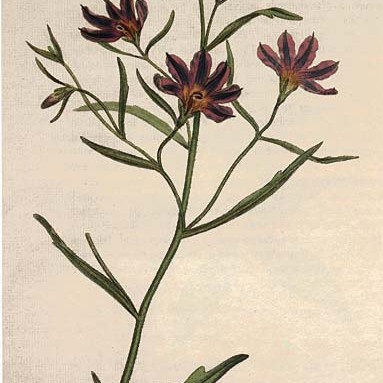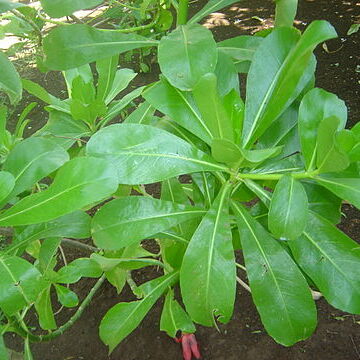Herbs, shrubs, or rarely small trees [or vines], without laticifers. Stipules absent. Leaves alternate, rarely opposite or whorled, simple. Inflorescences a cyme, raceme, head, or sometimes single flowered in axils. Flowers perfect, protandrous. Calyx epigynous, tubular, mostly (3-)5-lobed. Corolla sympetalous, irregular, 2-lipped or sometimes 1-labiate due to 2-segmentation of posterior lip to base; lobes 5, valvate, often induplicate. Stamens 5, alternate with corolla lobes, free from corolla or adnate to base of corolla tube; anthers 4-sporangiate and dithecal, introrse, longitudinally dehiscent. Ovary inferior, semi-inferior [or rarely (Velleia Smith) essentially superior], (1 or)2-locular [occasionally 4-locular (Scaevola porocarya F. Mueller)]; ovules 1 to many per locule, on axile or basal-axile placentas, anatropous. Fruit usually a capsule, less often a drupe or a small nut, often with persistent calyx. Seeds with a straight embryo embedded in copious endosperm.
Trees, shrubs or herbs, without latex. Leaves alternate, rarely opposite, or radical, exstipulate, simple, often obovate to spathulate. Inflorescence cymose or reduced to solitary axillary flowers. Flowers hermaphrodite, protandrous, irregular. Calyx adnate to the ovary basally, distally free as a 5-toothed or entire limb. Corolla with a long tube split for part or all of its length and a limb divided into 5 subequal lobes. Stamens 5, from the base of the corolla, free or occasionally joined at the anthers; anthers dehiscing introrsely. Ovary superior to inferior, 1–2-locular, each containing 1 or several ovules; style emerging laterally from the split corolla-tube, bearing a cup-shaped ciliate indusium around the simple or bifid stigma. Fruit a capsule or drupe. Seeds with endosperm
Stamens 5, alternating with the corolla–lobes and inserted at the base of the corolla, usually free but sometimes joined with the anthers; anthers 2–thecous, with the theca parallel and opening longitudinally
Stamens 5, alternate with the corolla-lobes, free or rarely shortly adnate to the corolla; anthers 2-celled, free or connivent around the style
Style simple or rarely divided, emerging laterally from the split corolla–tube; stigma truncate or bilobed, with an apical indusium
Flowers sometimes solitary and axillary but more often arranged in a spike, raceme or panicle, hermaphrodite, protandrous
Calyx tubular, adnate to the ovary or very rarely free; limb consisting of 5 persistent lobes, rarely entire
Corolla sympetalous, 5–merous, bilabiate or very rarely 1–lipped; tube long, often villous inside
Leaves usually alternate, rarely opposite, sometimes all radical, entire, simple, exstipulate
Corolla gamopetalous, bilabiate or rarely 1-lipped, lobes valvate, often induplicate
Herbs, small shrubs or rarely shrubs or small trees without latex, rarely spinescent
Seeds with endosperm, small, flat, with a thin or thick and often crustaceous testa
Ovary mostly inferior, 1–2 (–4)–locular; ovules 1–several, erect or ascending
Seeds small, with straight embryo in the middle of copious endosperm
Ovary mostly inferior, 1-4-celled; stigma indusiate at the top
Leaves alternate or rarely opposite; stipules absent
Ovules 1 or more in each cell, erect or ascending
Calyx tubular, adnate to the ovary, rarely free
Fruit drupaceous or nut-like, or capsular
Fruit a drupe, capsule or nutlike
Lobes valvate, subequal
Disc sometimes present
Herbs or undershrubs
Flowers zygomorphic


